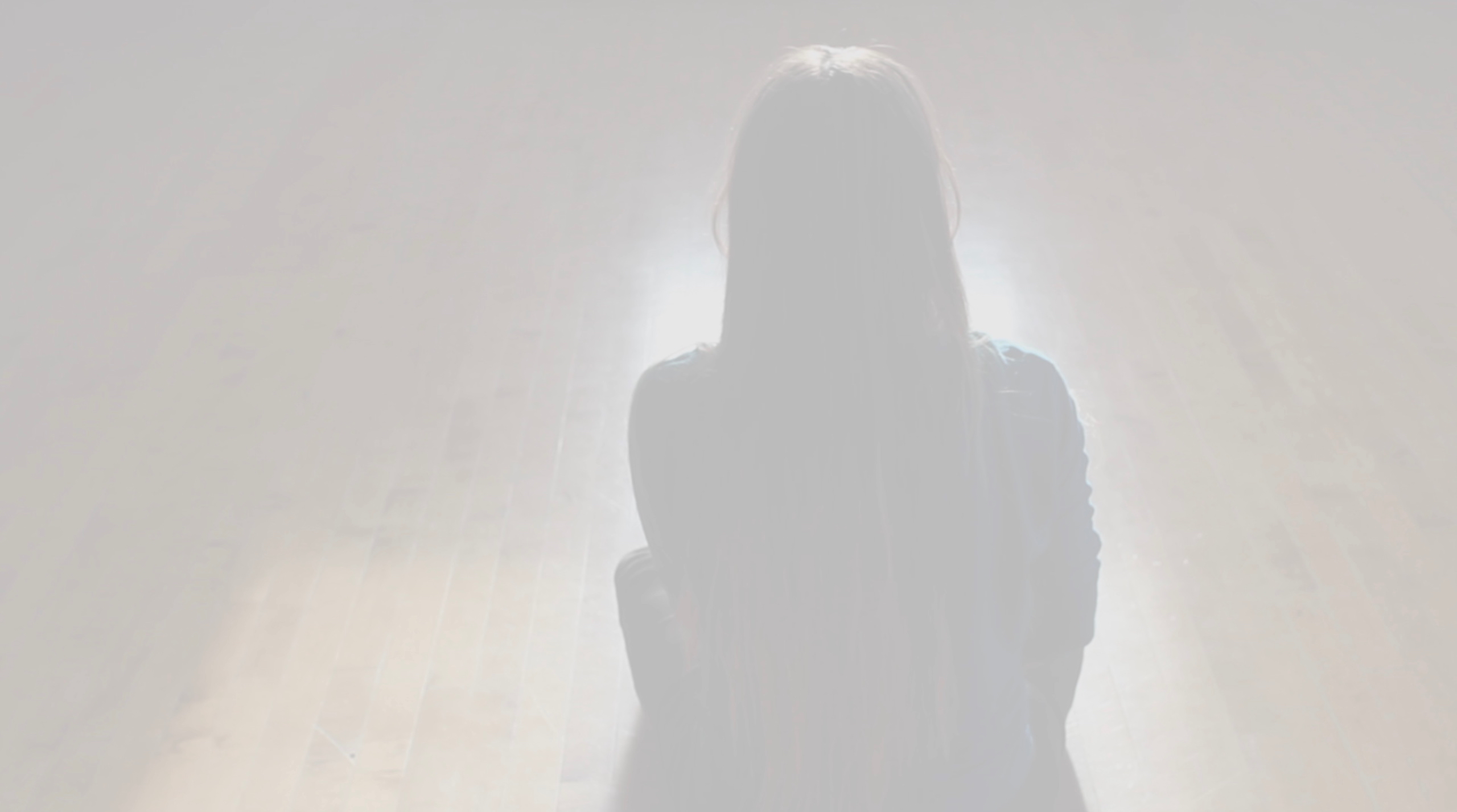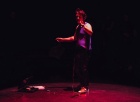Sexy. Strange. Sultry. The six short films in the 2018 series a quiet flamenco, shot and created by Calgary artist and filmmaker Rosanna Terracciano, draw out the sounds and movements of flamenco through imagery, motion, and verbal and nonverbal cues. One might expect from the title an abundance of visuals encircled by a buoyant silence: a lack of sound that floats with the movement of each dancer. This is not quite the case as Terracciano’s series expands upon the conventional understandings of flamenco.
a quiet flamenco offers the audience an opportunity to reacquaint themselves with flamenco by presenting a different relationship between sound and dance. While flamenco is traditionally a cacophonous dance, Terracciano uses minimal sound, which might appear at odds with its foundations. Terracciano describes her motivation as “Ultimately, I wanted to create this project because I was tired of seeing the internet/screens/media saturated with always the same stereotypical images of power and fire and drama that are usually associated with flamenco dance. In my own small way, I wanted to add a different side to the picture, one that showed the full range of the depth of emotion that can be associated with flamenco, one that showed strength in the vulnerability.”1
Terracciano’s 2018 film series is part of this year’s edition of PARTICLE + WAVE, a Calgary-based media arts festival. Screening at EMMEDIA Gallery from February 1 to March 2, 2019, a quiet flamenco features six highly accomplished and influential Canadian flamenco dancers. The filmmaker removes the accompaniment of guitar almost entirely and instead concentrates on vocals as well as other aural aspects.
Traditional flamenco focuses on specific characteristics of the dance including “the freedom and pride of posture, flirtatious movements by the female, deplantes, and the richness of bodily expression, sensitivity and profoundness of movement.”2 Terracciano’s short films focus on the sounds bodies make during a performance, including quiet, frequent hand tapping on hands or legs to create a rhythm or beat. In her artist statement, Terracciano notes that while in a traditional flamenco dance there is a great deal of emotional intensity and extreme expression, she aims to expose the introverted and less forceful sides of the dance.3
This idea becomes particularly clear in two films in the series: Myriam Allard and Sarah Bronsard. The dancer in Sarah Bronsard moves across the floor using her torso as the primary means of dancing. Bronsard rests or scrolls her body horizontally across the floor, becoming vulnerable as she moves silently across the space. In Myriam Allard, the dancer’s movements are mirrored by the sound in the film while her image is skewed between intermittent movement and closeup shots of her head and face. Allard also performs in a horizontal position at times. She does not exhibit many of the traditional components or sounds of flamenco, depicting another side to the dance that is often not explored.
The films are beautiful and moving while mysterious. Each film focuses on an individual dancer and begins with their name spoken. This acts as a relational moment: the dancers speaking their names identifies them personally through their voice and presence, further emphasizing their singular existence within the film. a quiet flamenco provides opportunities for the audience to feel the movement and emotions as intimately connected to the dancer’s body. This is especially emphasized in the films Myriam Allard and Veronica Maguire. In the opening of Myriam Allard, we see not only Allard herself but her reflection, doubling her presence. Her face comes in and out of focus as her voice carries through the entire film singing and humming. She moves rhythmically, her skirt ruffling on the floor, the only other sound we hear. In Veronica Maguire, initially we see only Maguire’s hands tapping against one another softly - a gentle, near soundless movement. Her body is obscured by a bird cage and seen through a window. Terracciano uses her camera to shroud Maguire’s identity by blurring her appearance until she is only a colour field.
In a quiet flamenco, Terracciano seems less concerned with the character and movement of flamenco and more so with the personalities - the very personhood - of the dancers themselves and how that can be translated into dance. This is particularly the case in the films Oscar Nieto and Claire Marchand. Nieto is heard singing before he is seen on screen. When he appears, he is only ever partially visible; he is persistently obscured through mirrors or through the use of the camera. However, his voice carries through the film. Terracciano brings Nieto’s singing voice into focus, an aspect that might not otherwise be visible in traditional flamenco. The filmmaker’s approach gives the audience the opportunity to feel like they know the dancer by seeing how they interact and communicate with the dance itself. This is equally true of Marchand who brings her body into stillness as opposed to moving into action. It is the positioning of her body that communicates rather than how she moves with the music.
"In my own small way, I wanted to add a different side to the picture, one that showed the full range of the depth of emotion that can be associated with flamenco, one that showed strength in the vulnerability.”
In several of the short films, Terracciano uses the camera to further comment on the dancer’s personality. In Oscar Nieto, she spins the camera around as if to mimic the movement of a flamenco dancer. Nieto comes in and out of the shot, purposefully refocusing our attention on the dancer in different configurations. This allows Terracciano to shift perspective by physically turning the camera in circles refocusing the audience’s attention with each concentric turn. In the film Claire Marchand, the filmmaker uses a compelling filmic technique to echo the dancer’s figure three times. The dancer, in effect, does not move but holds her body in stillness surrounded by these echoes. Marchand appears to be on the verge of movement. Stillness is emphasized rather than movement, creating a compelling dichotomy between our understanding of traditional flamenco dancing and Terracciano’s alternative positioning of flamenco.
Despite its title, this series of films is anything but quiet. Terracciano’s use of the adverb speaks more to her approach of capturing how each artist dances. She explores the periphery of flamenco, crossing its boundaries gently and tenderly to express the other aspects of what the dance can be. She exposes the potentialities and multiplicity of flamenco. The quiet resides in the nuances, the in-betweens, the reinterpretations. a quiet flamenco points the viewer to the inside or inner conscience of the dance, the intuitive dialogue that happens between the dancer and the act of performing. In this series, what we know of flamenco is reinvented before our eyes.
The quiet resides in the nuances, the in-betweens, the reinterpretations. a quiet flamenco points the viewer to the inside or inner conscience of the dance, the intuitive dialogue that happens between the dancer and the act of performing.
The films in a quiet flamenco are united through the movement, placement, and geography of the body. A form of flamenco is synthesized within each film which is reflected through Terracciano’s camera work and filmic aesthetics. Terracciano states, “My films are typically created using an improvised process, and this extended into this project also. Ahead of filming, each artist was asked to prepare a short phrase of movement material and was sent a series of questions to contemplate regarding searching for their own form of "quiet" in flamenco.”4Her filming and editing techniques are starting points to initiate the improvisation and interplay between body and camera. Through her use of the camera as an active body itself, Terracciano links the movement or stillness of the dancers’ bodies across the films. The viewer thus becomes a more active observer rather than using a merely passive gaze watching the dance unfold.
In each film the subject, object, and setting become abstracted in order to diverge from what flamenco is traditionally understood to be. In her artist statement, Terracciano describes the series as “a support of a flamenco that is stripped of the tired stereotypes that don’t serve the integrity of the form and that hinder any potential for critical discourse.”5Indeed, her six films are just that. By allowing the dancers freedom of form, sound, and shape, a quiet flamenco breaks with tradition and fosters a new understanding of dance within the genre. In her films, Terracciano transforms flamenco in ways that we might previously have believed to be immutable.
Terracciano will be interacting with her video installation through various durational performances over the course of the PARTICLE + WAVE exhibition from February 1 - March 2, 2019. A schedule of Terracciano’s durational performances can be found on EMMEDIA’s website: http://emmedia.ca/2018/12/a-quiet-flamenco/.
Maeve Hanna is a freelance writer newly based in Calgary. She has written for Luma previously as well as Black Flash magazine, C Magazine, Canadian Art, esse, Frieze, Galleries West, Sculpture Magazine among others. Maeve holds a BFA Honours in Visual Arts and English Literature from York University and the University of Leeds and an MA in Art History from Université du Québec à Montréal and the University of Manitoba on location in Iceland.







